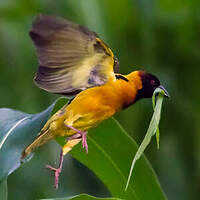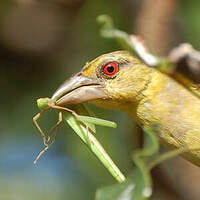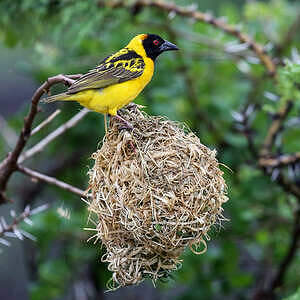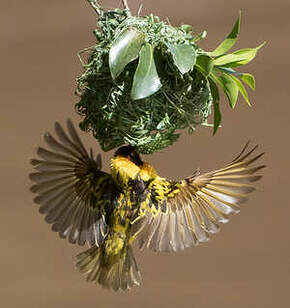Village Weaver
Ploceus cucullatus - Tisserin gendarme
Identification
The Village Weaver is a large weaver with a strong beak. During reproduction, the sexual dimorphism is well marked. The nuptial male is remarkable for its colours, which vary according to the subspecies. The male of the ssp type cucullatus is darker than the others. It has a head covered with a hood, black on the face and sides, and chestnut on the nape. The black of the throat descends to a point on the upper chest while the chestnut of the nape outlines a collar under the hood. The strong black beak merges into the black face. The iris of the eye is bright red.
On the very contrasting upper parts yellow and black are found in equal proportions. The wings and tail, quite short, are of a brown-olive green with yellow edges on the feathers. The legs are pink.
The lower parts are a yellow more or less washed with chestnut. Most often it is the top of the chest, at the contact of the black tie, and the flanks that are the most coloured. The belly and undertail coverts can be golden yellow. Some very marked males have their undersides entirely of a pronounced chestnut-orange.
The males of the other subspecies are recognized by the aspect of the head. In the Abyssinian male of the Horn of Africa, the chestnut is much less marked. In nigriceps, from the centre-east, the nape is yellow. In collaris, from the centre-west, the nape is black, so that the hood is entirely black and contrasts well with the yellow of the rest of the body. Finally, in spilonotus of the south of the continent, the crown and nape are yellow and the chestnut tone is absent. The non-nesting male resembles the female, except for the male collaris which has no inter-nuptial plumage.
The nuptial female, smaller than the male, has much paler and much less contrasting plumage. The top and sides of the head are olive with an intercalated yellow eyebrow.The beak is two-tone, with the upper mandible blackish and the lower greyish with a horn base. The iris is red.
The upper parts are a fairly cold grey-brown, tinged with olive and spotted with darkness. The wings are dark olive-brown with yellowish edgings on the remiges and coverts, the tail is olive.
The undersides are yellow, often bright yellow at the level of the throat and upper chest and less yellow further away, sometimes whitish tinged with yellow, with either individual or subspecies-related variations. The legs are pink. Some females can have male-type feathers scattered in the plumage.
The inter-nuptial female is less yellow underneath. The chest and flanks are grey-beige, the belly and undertail white.
The juvenile resembles the female, but its beak is light and its iris brown. The immature is intermediate between the juvenile and the adult of its sex.
Subspecific information 8 subspecies
- Ploceus cucullatus cucullatus (Mauritania, Senegal and Gambia to s Chad and Cameroon, Bioko I.)
- Ploceus cucullatus abyssinicus (n Sudan, Eritrea and Ethiopia)
- Ploceus cucullatus bohndorffi (s Sudan, n DRCongo, Uganda, w Kenya and nw Tanzania)
- Ploceus cucullatus frobenii (s and se DRCongo)
- Ploceus cucullatus collaris (Gabon, w DRCongo and Angola)
- Ploceus cucullatus graueri (e DRCongo, Rwanda and w Tanzania)
- Ploceus cucullatus nigriceps (s Somalia and e Kenya through e and s Tanzania to se DRCongo, s Angola and ne Namibia, w Zimbabwe, e Zambia and c Mozambique)
- Ploceus cucullatus spilonotus (se Botswana, e South Africa and s Mozambique)
Foreign names
- Tisserin gendarme,
- Tejedor común,
- tecelão-malhado,
- Dorfweber,
- málinkó-szövőmadár,
- Grote Textorwever,
- Tessitore gendarme,
- byvävare,
- Landsbyvever,
- pletiarka dedinská,
- snovač zahradní,
- Stor Maskevæver,
- kyläkutoja,
- Bontrugwewer,
- teixidor urbà,
- Uxavefari,
- wikłacz zmienny,
- vaški tkalec,
- Большой масковый ткач,
- ズグロウロコハタオリ,
- 黑头织雀,
- byvävare,
- 黑頭群棲織布鳥,
Voice song and call
The Village Weaver is very vocal, especially within colonies. Literature mentions around 20 different calls for the various phases of the bird's biorhythm. The call is a tchip or tjip which sounds like a sparrow's cry. The song is a sequence of phrases that start with a gabbling made of liquid warbling notes that pleasant to the ear and ends with drawn-out, grating or creaking whistles, t-t-t-t-shirrrrzzzrrrerrr".
Habitat
The Village Weaver is eclectic in its habitat choice. It can be found in both wild habitats such as wooded savannah, forest clearings, riverside forests, wetlands, as well as anthropic habitats such as cultivated areas and rural habitats with gardens. It is absent from dense forests as well as arid areas. The presence of large trees is necessary for nesting, but in wetlands, large helophytes such as reeds can support the nest.
Behaviour character trait
The Village Weaver is a very social bird year round. They forage in groups at dedicated sites. They breed in populous colonies.
Depending on the habitat, a colony can settle on one or more nearby trees. Each tree can house up to 200 individuals, with usually more females than males, which is why polygamous behavior is common in males of the species. The colony is very active and noisy. The males spend their days doing incessant trips to get construction materials. A colony has its own supply site, usually being a wooded area with palm trees, banana trees, sorghum, and acacias. The males build the nest and try to seduce the female by parading at its entrance. Outside of the breeding season, the birds, which may be from different colonies, gather in dorms far from human habitations. They are considered crop pests, but on the other hand, they eat many insects which can also be pests. The balance is nonetheless in their favor.Dietfeeding habits
The Village Weaver feeds in groups on the ground or in vegetation. Its diet is mixed. Follow up in Uganda showed that it consisted of 80% of plant items and 20% of animal items.
It eats a wide variety of seeds, including cereals, and fruits of all kinds from which it removes the fleshy part, such as Ficus fruits. It is also a fan of nectar from very diverse plant species (Bombax, Aloe,...). The animal part includes all kinds of invertebrates, mainly insects such as beetles, ants, termites, orthoptera, etc.Reproduction nesting
The nesting period depends on the rainy season in the area concerned. At this time, the Village Weaver is fond of humans, hence its English name. The male is in charge of building the nest. He weaves it with his beak, using mainly palm and banana trees as materials. He tears green leaves with his beak to make strands. Depending on the nesting site, he can use other plant elements.
The nest is spherical, suspended from one or two attachment points at the end of a bare branch, increasing its visibility and thus that of the colony. It has an opening facing down at the end of a very small tunnel that allows access to the inner chamber.
The male alternates building and parade sequences. He hangs from his feet at the entrance to the nest, flapping his wings and chirping. During the season he can build up to 20 nests. He can also dismantle a nest if he finds it unsuitable, too old or badly placed, cutting the fibers that hold it to the branch with his beak.
The female lays 2-4 speckled or uniform eggs, which she incubates alone for 9-14 days. The chicks are mainly fed by the female, with the male's contribution varying depending on the region and the temporal position of the nest. Their diet is exclusively insectivorous for the first 4 days, then includes seeds. Activity peaks in the search for food early in the morning and late in the evening.
As in the search for materials, each colony has the same foraging site, rarely far from the nesting site.
Once the first reproduction has been undertaken, the male can attract a second female and build a second nest.A third can follow, or even a fourth, depending on the context of the colony.
Geographic range
The Village Weaver is found throughout Sub-Saharan Africa, except for a large area covering Namibia, Botswana, and two thirds of South Africa. It was introduced (ssp type) around the Caribbean Sea (Haiti, Dominican Republic, Puerto Rico, Martinique, Venezuela), as well as in Portugal, and for the spilonotus sub-species in southern Africa, in Mauritius and Reunion.
Threats - protection
IUCN conservation status
concern
in the Wild
threatened
evaluated
The total population of the Village Weaver has not been quantified, but it is likely not declining; the species is said to be abundant. Its ability to adapt makes it easier for its numbers to increase, especially in areas where it has been introduced. As a crop ravager, it has been subject to multiple regulatory attempts in its new colonies in the Indian Ocean and Haiti, which have failed.
Sources of information
- IOC World Bird List (v15.1), Gill, F and D Donsker (Eds). 2025-12-07.
- Oiseaux des iles de l'océan Indien, Langrand Olivier, ian Sinclair
- Birds of Western Africa, Nick Borrow and Ron Demey
- Birds of Southern Africa, Ian Sinclair, Phil Hockey, Warwick Tarboton
- HBW Alive,
- Wikipedia (English version),
- BirdLife International, BirdLife International
- Société d'Etudes Ornithologiques de la Réunion ,
- xeno-canto, Sharing bird sounds from around the world,
Other sources of interest
 Specification sheet created on
25/07/2023 by Nathalie Santa Maria
Specification sheet created on
25/07/2023 by Nathalie Santa MariaTranslation by AI Oiseaux.net
© 1996-2025 Oiseaux.net
- Accipitriformes
- Aegotheliformes
- Anseriformes
- Apodiformes
- Apterygiformes
- Bucerotiformes
- Caprimulgiformes
- Cariamiformes
- Casuariiformes
- Charadriiformes
- Ciconiiformes
- Coliiformes
- Columbiformes
- Coraciiformes
- Cuculiformes
- Eurypygiformes
- Falconiformes
- Galliformes
- Gaviiformes
- Gruiformes
- Leptosomiformes
- Mesitornithiformes
- Musophagiformes
- Nyctibiiformes
- Opisthocomiformes
- Otidiformes
- Passeriformes
- Pelecaniformes
- Phaethontiformes
- Phoenicopteriformes
- Piciformes
- Podargiformes
- Podicipediformes
- Procellariiformes
- Psittaciformes
- Pterocliformes
- Rheiformes
- Sphenisciformes
- Steatornithiformes
- Strigiformes
- Struthioniformes
- Suliformes
- Tinamiformes
- Trogoniformes

































